北师大版选修8Unit22 Environmental Protection Endangered Species(共15张PPT)
文档属性
| 名称 | 北师大版选修8Unit22 Environmental Protection Endangered Species(共15张PPT) |

|
|
| 格式 | zip | ||
| 文件大小 | 37.6KB | ||
| 资源类型 | 教案 | ||
| 版本资源 | 北师大版 | ||
| 科目 | 英语 | ||
| 更新时间 | 2015-03-20 10:19:12 | ||
图片预览


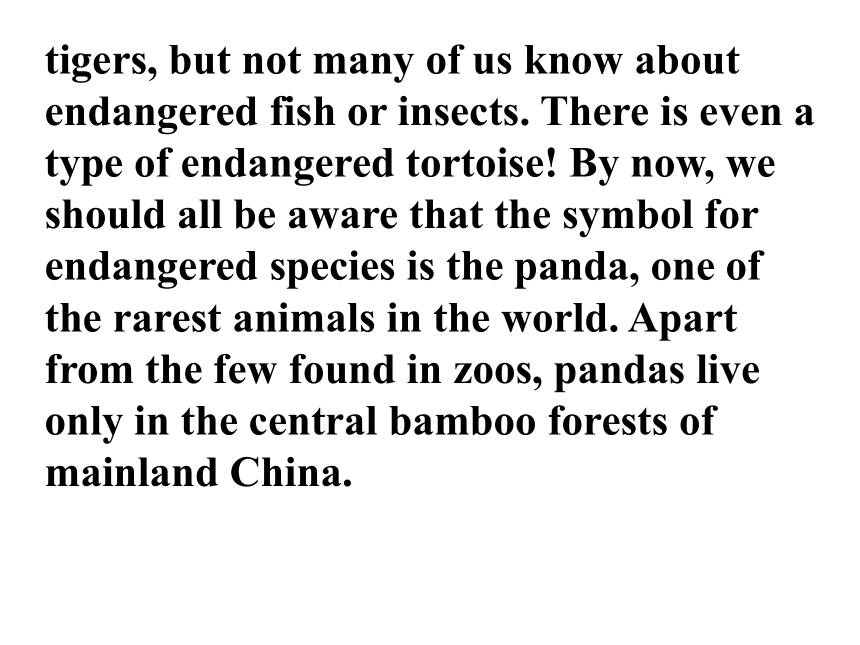
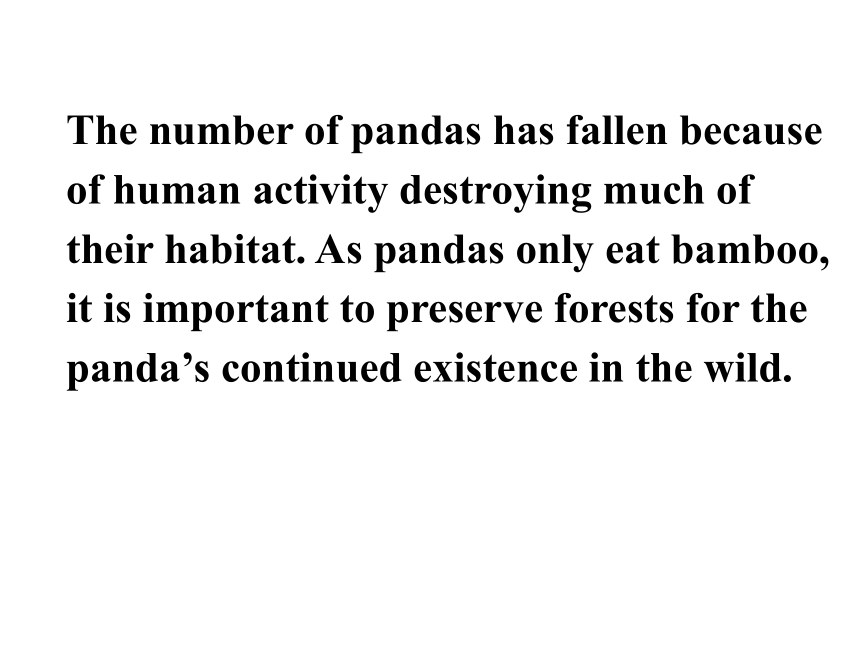
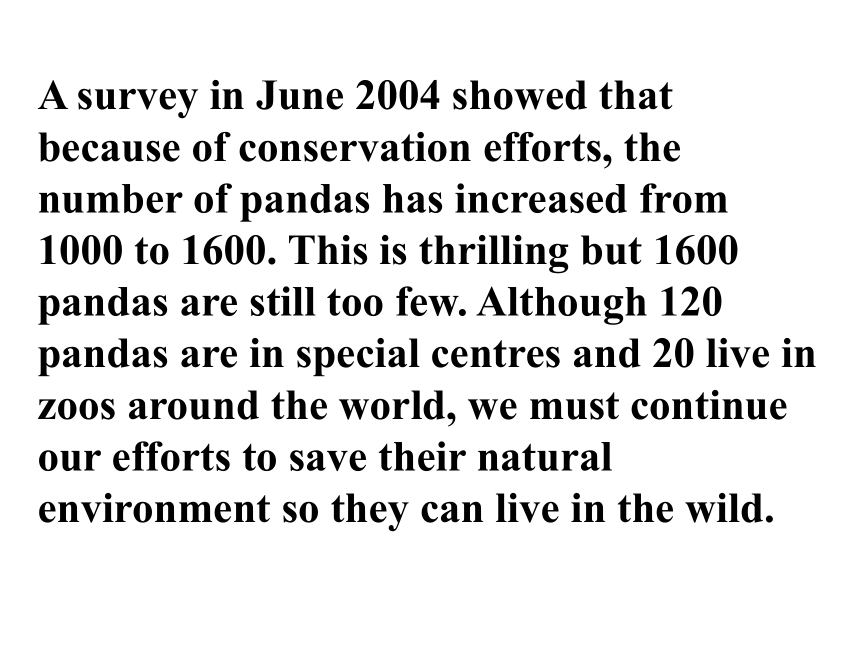
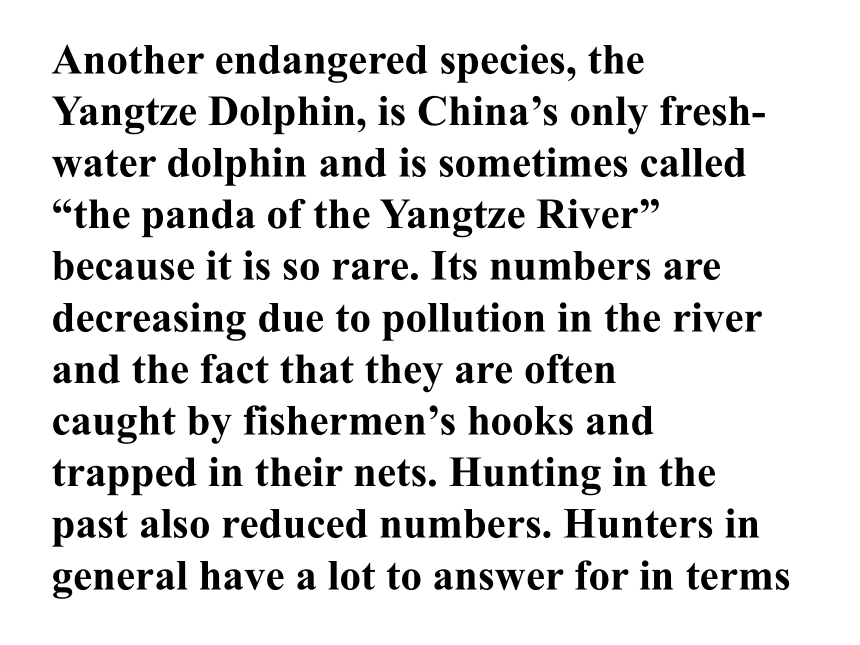
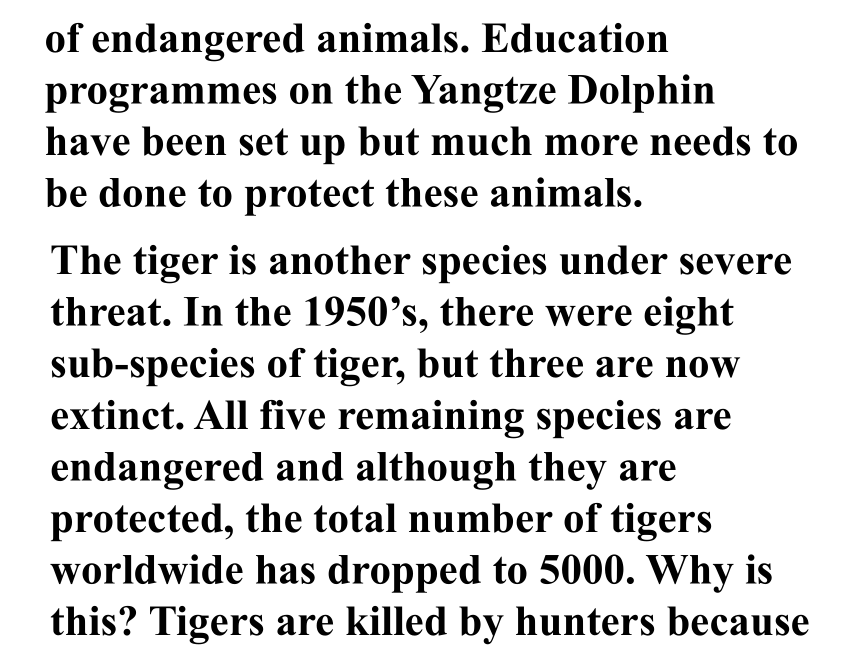
文档简介
课件15张PPT。Listening StrategiesListen for “topic” words, e.g. endangered, species, decrease. These words are usually stressed and the facts are often repeated, e.g. rare, few, extinct.
List your main points using numbers. This makes your notes easier to read when you look at them later.
Don’t try to write down everything; select important information.
Use abbreviations and your own shorthand.3. Listen to the lecture. Use the strategies to write some notes.TapescriptToday’s lecture will focus on the serious problem of endangered species. There are
thousands of endangered species in the world and if the rate at which species are
becoming extinct continues to rise, then millions of species will become extinct in the next decade. Most of us know about the big animals that are endangered, like tigers, but not many of us know about endangered fish or insects. There is even a type of endangered tortoise! By now, we should all be aware that the symbol for endangered species is the panda, one of the rarest animals in the world. Apart from the few found in zoos, pandas live only in the central bamboo forests of mainland China.The number of pandas has fallen because of human activity destroying much of their habitat. As pandas only eat bamboo, it is important to preserve forests for the panda’s continued existence in the wild.A survey in June 2004 showed that because of conservation efforts, the number of pandas has increased from 1000 to 1600. This is thrilling but 1600 pandas are still too few. Although 120 pandas are in special centres and 20 live in zoos around the world, we must continue our efforts to save their natural environment so they can live in the wild.Another endangered species, the Yangtze Dolphin, is China’s only fresh-water dolphin and is sometimes called “the panda of the Yangtze River” because it is so rare. Its numbers are decreasing due to pollution in the river and the fact that they are often
caught by fishermen’s hooks and trapped in their nets. Hunting in the past also reduced numbers. Hunters in general have a lot to answer for in termsof endangered animals. Education programmes on the Yangtze Dolphin have been set up but much more needs to be done to protect these animals.The tiger is another species under severe threat. In the 1950’s, there were eight
sub-species of tiger, but three are now extinct. All five remaining species are endangered and although they are protected, the total number of tigers worldwide has dropped to 5000. Why is this? Tigers are killed by hunters becauseit is falsely believed that parts of the tiger’s body are good for people’s health. Every year police seize bags of tiger parts and arrest illegal hunters but sadly, many never get caught. Another reason why numbers have decreased is the loss of the tiger’s natural habitat. To save these beautiful animals, we need to call for an end to illegal hunting and improve our conservation programmes or else face a future without tigers.To wrap up this lecture, I want to remind you that animals have no voice in our world. We need to speak out on their behalt before they disapear for good.7. Listen to the dialogue and complete the Function File with these expressions.Answers:
that’s why
2. to
3. basically
4. That’s the reason why
5. One reason
6. a lot of it is to do with
7. so that
8. Because of thatTapescript:
A: That was a great lecture. We really need to work at protecting our environment.
B Yes, that’s why I’m thinking of joining one of those conservation programmes to save an endangered animal.
A: Great! Which one?
B: Well, I would like to help save the Yangtze alligator. It’s one of the world’s most endangered animals.A: Where does it live exactly?
B: In the Yangtze River--- the lower part.
A: Aren’t there lots of people there?
B: Yes, basically, that’s the problem. Their habitat is being destroyed and local farmers kill them.
A: Why?
B: Because the alligators live in holes that damage the farmland and sometimes carry off farm animals. That’s the reason why they are killed.A: What can be done?
B: Well, our government is developinga conservation plan to protect them and I’d like to be part of it.
A: Sounds terrific. I’d like to save the beautiful Tibetan antelope. Forty or fifty years ago, there were up to a million living in Tibet.
B: And now?
A: Well, the numbers have been declining rapidly. There may be 75000 but there could be as few as 65000.B: Why?
A: One reason is their meat, but a lot of it is to do with their wool. It’s made into scarves and is very fashionalbe in Europe and the US. They are being hunted because of it.
B: It’s illegal to kill a Tibetan antelope, isn’t it?A: Yes--- the government is trying to enforce the law so that they are protected but the demand for wool means hunters continue to kill. Because of that, the numbers are falling quickly.
B: Well, all in all, if we help protect these animals and spread the news about conservation, we will be doing our bit and hopefully our grandchildren will still be able to see these beautiful creatures in the wild.
List your main points using numbers. This makes your notes easier to read when you look at them later.
Don’t try to write down everything; select important information.
Use abbreviations and your own shorthand.3. Listen to the lecture. Use the strategies to write some notes.TapescriptToday’s lecture will focus on the serious problem of endangered species. There are
thousands of endangered species in the world and if the rate at which species are
becoming extinct continues to rise, then millions of species will become extinct in the next decade. Most of us know about the big animals that are endangered, like tigers, but not many of us know about endangered fish or insects. There is even a type of endangered tortoise! By now, we should all be aware that the symbol for endangered species is the panda, one of the rarest animals in the world. Apart from the few found in zoos, pandas live only in the central bamboo forests of mainland China.The number of pandas has fallen because of human activity destroying much of their habitat. As pandas only eat bamboo, it is important to preserve forests for the panda’s continued existence in the wild.A survey in June 2004 showed that because of conservation efforts, the number of pandas has increased from 1000 to 1600. This is thrilling but 1600 pandas are still too few. Although 120 pandas are in special centres and 20 live in zoos around the world, we must continue our efforts to save their natural environment so they can live in the wild.Another endangered species, the Yangtze Dolphin, is China’s only fresh-water dolphin and is sometimes called “the panda of the Yangtze River” because it is so rare. Its numbers are decreasing due to pollution in the river and the fact that they are often
caught by fishermen’s hooks and trapped in their nets. Hunting in the past also reduced numbers. Hunters in general have a lot to answer for in termsof endangered animals. Education programmes on the Yangtze Dolphin have been set up but much more needs to be done to protect these animals.The tiger is another species under severe threat. In the 1950’s, there were eight
sub-species of tiger, but three are now extinct. All five remaining species are endangered and although they are protected, the total number of tigers worldwide has dropped to 5000. Why is this? Tigers are killed by hunters becauseit is falsely believed that parts of the tiger’s body are good for people’s health. Every year police seize bags of tiger parts and arrest illegal hunters but sadly, many never get caught. Another reason why numbers have decreased is the loss of the tiger’s natural habitat. To save these beautiful animals, we need to call for an end to illegal hunting and improve our conservation programmes or else face a future without tigers.To wrap up this lecture, I want to remind you that animals have no voice in our world. We need to speak out on their behalt before they disapear for good.7. Listen to the dialogue and complete the Function File with these expressions.Answers:
that’s why
2. to
3. basically
4. That’s the reason why
5. One reason
6. a lot of it is to do with
7. so that
8. Because of thatTapescript:
A: That was a great lecture. We really need to work at protecting our environment.
B Yes, that’s why I’m thinking of joining one of those conservation programmes to save an endangered animal.
A: Great! Which one?
B: Well, I would like to help save the Yangtze alligator. It’s one of the world’s most endangered animals.A: Where does it live exactly?
B: In the Yangtze River--- the lower part.
A: Aren’t there lots of people there?
B: Yes, basically, that’s the problem. Their habitat is being destroyed and local farmers kill them.
A: Why?
B: Because the alligators live in holes that damage the farmland and sometimes carry off farm animals. That’s the reason why they are killed.A: What can be done?
B: Well, our government is developinga conservation plan to protect them and I’d like to be part of it.
A: Sounds terrific. I’d like to save the beautiful Tibetan antelope. Forty or fifty years ago, there were up to a million living in Tibet.
B: And now?
A: Well, the numbers have been declining rapidly. There may be 75000 but there could be as few as 65000.B: Why?
A: One reason is their meat, but a lot of it is to do with their wool. It’s made into scarves and is very fashionalbe in Europe and the US. They are being hunted because of it.
B: It’s illegal to kill a Tibetan antelope, isn’t it?A: Yes--- the government is trying to enforce the law so that they are protected but the demand for wool means hunters continue to kill. Because of that, the numbers are falling quickly.
B: Well, all in all, if we help protect these animals and spread the news about conservation, we will be doing our bit and hopefully our grandchildren will still be able to see these beautiful creatures in the wild.
